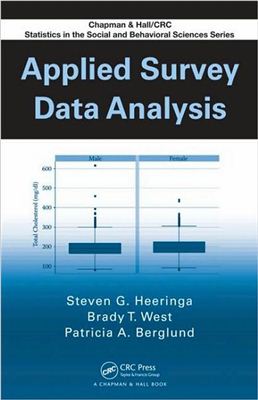Chapman & Hall/CRC – 2010, 462 pages
ISBN: 1420080660
Taking a practical approach that draws on the authors’ extensive teaching, consulting, and research experiences, Applied Survey Data Analysis provides an intermediate-level statistical overview of the analysis of complex sample survey data. It emphasizes methods and worked examples using available software procedures while reinforcing the principles and theory that underlie those methods.
After introducing a step-by-step process for approaching a survey analysis problem, the book presents the fundamental features of complex sample designs and shows how to integrate design characteristics into the statistical methods and software for survey estimation and inference. The authors then focus on the methods and models used in analyzing continuous, categorical, and count-dependent variables; event history; and missing data problems. Some of the techniques discussed include univariate descriptive and simple bivariate analyses, the linear regression model, generalized linear regression modeling methods, the Cox proportional hazards model, discrete time models, and the multiple imputation analysis method. The final chapter covers new developments in survey applications of advanced statistical techniques, including model-based analysis approaches.
Designed for readers working in a wide array of disciplines who use survey data in their work, this book also provides a useful framework for integrating more in-depth studies of the theory and methods of survey data analysis. A guide to the applied statistical analysis and interpretation of survey data, it contains many examples and practical exercises based on major real-world survey data sets.
There are many quality software choices out there for survey data analysts. We selected Stata® for all book examples due to its ease of use and flexibility for survey data analysis, but examples have been replicated to the greatest extent possible using the SAS®, SPSS®, IVEware, SUDAAN®, R, WesVar®, and Mplus software packages on the book Web site (http://www.isr.umich.edu/src/smp/asda/ ). Appendix A reviews software procedures that are currently available for the analysis of complex sample survey data in these other major software systems.
Examples based on the analysis of major survey data sets are routinely used in this book to demonstrate statistical methods and software applications. To ensure diversity in sample design and substantive content, example exer- cises and illustrations are drawn from three major U.S. survey data sets: the 2005–2006 National Health and Nutrition Examination Survey (NHANES); the 2006 Health and Retirement Study (HRS); and the National Comorbidity Survey-Replication (NCS-R). A description of each of these survey data sets is provided in Section. A series of practical exercises based on these three data sets are included at the end of each chapter on an analysis topic to pro- vide readers and students with examples enabling practice with using statis- tical software for applied survey data analysis.
ISBN: 1420080660
Taking a practical approach that draws on the authors’ extensive teaching, consulting, and research experiences, Applied Survey Data Analysis provides an intermediate-level statistical overview of the analysis of complex sample survey data. It emphasizes methods and worked examples using available software procedures while reinforcing the principles and theory that underlie those methods.
After introducing a step-by-step process for approaching a survey analysis problem, the book presents the fundamental features of complex sample designs and shows how to integrate design characteristics into the statistical methods and software for survey estimation and inference. The authors then focus on the methods and models used in analyzing continuous, categorical, and count-dependent variables; event history; and missing data problems. Some of the techniques discussed include univariate descriptive and simple bivariate analyses, the linear regression model, generalized linear regression modeling methods, the Cox proportional hazards model, discrete time models, and the multiple imputation analysis method. The final chapter covers new developments in survey applications of advanced statistical techniques, including model-based analysis approaches.
Designed for readers working in a wide array of disciplines who use survey data in their work, this book also provides a useful framework for integrating more in-depth studies of the theory and methods of survey data analysis. A guide to the applied statistical analysis and interpretation of survey data, it contains many examples and practical exercises based on major real-world survey data sets.
There are many quality software choices out there for survey data analysts. We selected Stata® for all book examples due to its ease of use and flexibility for survey data analysis, but examples have been replicated to the greatest extent possible using the SAS®, SPSS®, IVEware, SUDAAN®, R, WesVar®, and Mplus software packages on the book Web site (http://www.isr.umich.edu/src/smp/asda/ ). Appendix A reviews software procedures that are currently available for the analysis of complex sample survey data in these other major software systems.
Examples based on the analysis of major survey data sets are routinely used in this book to demonstrate statistical methods and software applications. To ensure diversity in sample design and substantive content, example exer- cises and illustrations are drawn from three major U.S. survey data sets: the 2005–2006 National Health and Nutrition Examination Survey (NHANES); the 2006 Health and Retirement Study (HRS); and the National Comorbidity Survey-Replication (NCS-R). A description of each of these survey data sets is provided in Section. A series of practical exercises based on these three data sets are included at the end of each chapter on an analysis topic to pro- vide readers and students with examples enabling practice with using statis- tical software for applied survey data analysis.

